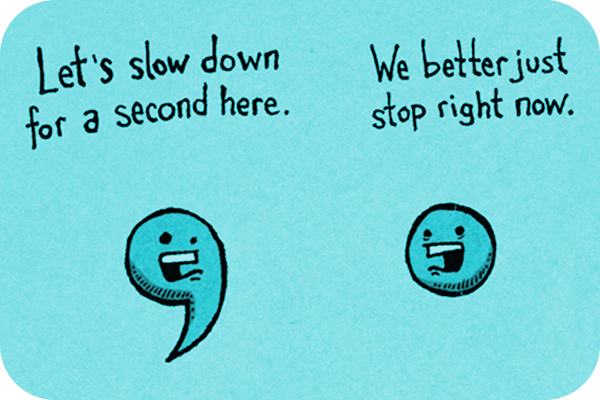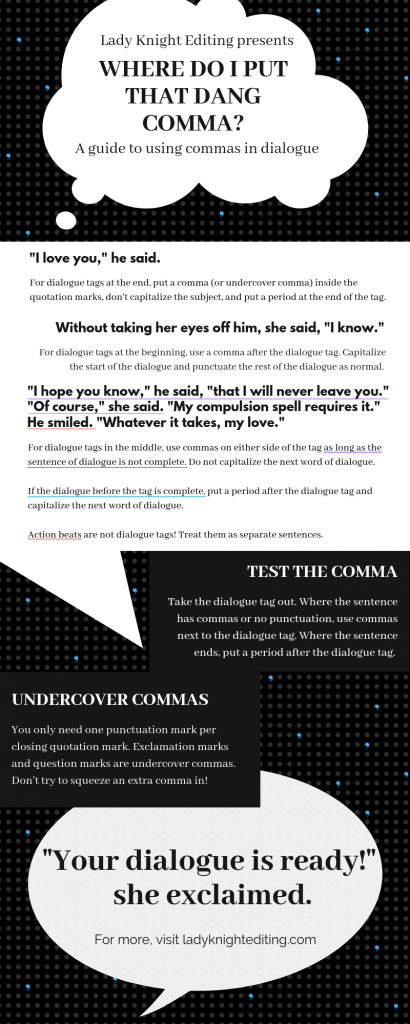If you’re writing fiction or memoir, you’ll probably write dialogue. I’ve posted a lot about the big picture of dialogue before, but I’ve never gone over the formatting basics. And dialogue punctuation mistakes are very common. I think a lot of the confusion stems from one simple question: where the heck do I put this comma?
To answer this question, let’s first consider what exactly commas and dialogue tags are, then see how we fit them together.
What is a Comma?
As I so often like to do, let’s go back into history to better understand the comma. Historically, most punctuation comes from the same basic idea. When alphabetical writing was first instituted, allthewordsweresquishedtogetherinoneunbrokensequence.1 All I have to say is, thank goodness for the invention of the space! And my gratitude increases for the invention of punctuation.
Historians are fairly certain that most early reading was done aloud.2 As such, early writers began inserting marks in their writing to indicate where the reader was meant to breathe.3 So the comma was born!

As punctuation developed, different marks came to indicate slightly different kinds of breaths. Your sentence-ending marks—like periods, exclamation marks, and question marks—show that a thought has come to a complete resolution. The sentence is over; take a deep breath; the next word will be capitalized and a new sentence begins. Commas, on the other hand, indicate a pause in the flow of words without bringing about a full break. It’s a quick breath, then you forge ahead to the end of the sentence.
So how does this apply to dialogue?
Dialogue Tags and Commas
A dialogue tag is the few words before or after a bit of dialogue that indicate who is speaking: he said, she asked, etc. If you’re grammatically minded, remember that the verb in a dialogue tag is typically transitive. It needs a direct object to make sense. He said isn’t a complete sentence. He said he loved me is. The dialogue tag is inextricably linked with the dialogue, which serves as the direct object. And when you have direct dialogue in quotation marks, you need a comma to link the quote with the dialogue tag.
When the line your character says is a complete sentence with a dialogue tag at the end, you use a comma inside the quotation mark and a period at the end of the dialogue tag.4 Like this:
“I like writing dialogue,” she said.
The comma shows that the sentence “I like writing dialogue” isn’t quite over. Take a quick breath but don’t come to a complete halt; you’re about to find out who said it.
Dialogue Tags at the Beginning
You can also put the dialogue tag first. In this case, the comma still goes next to the dialogue tag, just after instead of before. Then you use the sentence-ending punctuation inside the quotation mark:
He asked, “Are you sure?”5
A quick note: the verb in a dialogue tag should be something you can physically do to produce words. This does NOT include words such as smiled or laughed. These words more properly indicate action beats, and they should be punctuated as their own sentences:
“I’m positive.” She smiled. “How about you?”
Also be wary of using too many said bookisms (words like exclaimed or shouted). Said and the occasional asked are sufficient for the vast majority of your dialogue tags.
Dialogue Tags in the Middle

When you’re writing dialogue, you may want to mix things up. Sometimes you want to put the dialogue tag in the middle of your conversational sentence, for pacing or descriptive purposes. As long as the dialogue sentence isn’t over, you use commas on either side of the dialogue tag.
Take a look at this line from the first chapter of Brandon Sanderson’s Warbreaker:6
“So,” Vahr croaked, “you judge me, just like everyone else.”
The ‘Vahr croaked’ indicates a pause in what he said, but the sentence continues. We put commas on either side of the dialogue tag to indicate to the reader that the sentence isn’t over yet.

But sometimes you put the dialogue tag in the middle and still put a period after it. Take a look at these two consecutive lines from Katherine Addison’s The Goblin Emperor:
“Serenity,” said Beshelar, “are you sure—?”
“Yes,” Maia said. “Their deaths weigh no lighter on the earth than our father’s.”
See the comma after the first dialogue tag but the period after the second. In the first, Beshelar is saying “Serenity, are you sure?” In the second, Maia’s “Yes” is a definitive sentence of its own: “Yes. Their deaths weigh no lighter on the earth than our father’s.”
To see if you need a comma or a period, take the dialogue tag out. If the sentence would end with the words right before the dialogue tag, you use a comma inside the quotation marks and a period after the tag. If the sentence continues, use commas in both places.
To see if you need a comma or a period, test the sentence by taking the dialogue tag out.
The Undercover Comma

(from FreeVector)
Let’s go back to putting the dialogue tag at the end. What if your character is excited and you want to use an exclamation mark at the end of your dialogue? Or they’re asking a question? Do you still need a comma? The short answer is no.
The long answer is: You only want one punctuation mark next to a closing quotation mark. And as long as there’s a dialogue tag after that quote, whatever closing punctuation mark you use is an undercover comma.
“I love writing dialogue!” she said.
“Are you sure?” he asked.
The exclamation mark and the question mark are serving as commas. The dialogue tags “she said” and “he asked” are still not their own sentences, so you don’t capitalize the she or the he. And you don’t need to try to fit a comma in somewhere else like “I love writing dialogue!,” she said. Or “Are you sure?”, he asked.
Undercover commas work alone!
Every Comma in its Place
Whenever you write a comma, you’re showing your reader where to take a quick breath—but you’re not letting them end the sentence! Commas help the reader know more information is coming; the dialogue tag tells them who said what.
Remember that a dialogue tag can’t stand on its own. It always needs a comma (even an undercover one). If you’re not sure whether to use a comma or a period, take the dialogue tag out and see how the sentences fall. And then refer to my handy infographic for all your punctuation needs!
“Any questions?” she asked.
- See this BBC article on the history of punctuation for a nice little overview.
- Here’s an interview with a historian from Harvard on the subject.
- If you’re a singer, you may have noticed that the breath mark is a large, floating comma. It’s the same principle.
- Remember that in American English, a punctuation mark next to a closing quotation mark always goes inside the quotation mark.
- Notice that in the case of a dialogue tag before the dialogue, you capitalize both the tag (since it’s at the beginning of the sentence) and the quoted text (since it would be capitalized if it were on its own)
- I wanted to use the first line of the book as my example. But the dialogue in that sentence is an internal monologue, so it’s in italics instead of quotation marks. I didn’t want to throw another aspect into the mix just yet!



I’m very impressed with your knowledge and your writing skills and your ability to explain clearly. You are very accomplished both in writing and editing. You are a great help to writers and future writers. When I was in elementary school I wrote well because I had read a lot. When the teacher asked me about the rules of writing, I had no idea. I just copied the style of good writers. Not only do you make a great editor, you would make a great professor of English or literature.
Thank you so much! Your kind words mean a lot. I would love to be a professor someday. We’ll see what life has in store 🙂
I can’t thank you enough! I wish I would have had this article while writing my first few novels. I would get so confused how to properly punctuate dialogue. Very clear and concise and great examples. Thanks so much!
Thank you! I’m glad it was helpful 🙂
After writing dialogue for scripts, I find myself in need of a comma or two for dialogue in a novel project. I remembered having read this great explanation with an infographic a couple of years ago. Alas, it was on another computer. I tracked it down — thank you, Mr Google. You are now well and truly bookmarked. What a great writing resource this is. Thank you for your knowledge and generosity.
Glad you were able to find it again 🙂 Thanks for letting me know it’s been useful!
If I’m writing dialogue, for example:
“Hey there!” he yelled happily.
Should it be, “Hey there!” he yelled, happily.
I don’t know if a comma should be there, even if it’s a ly usage. I see a mix of it with dialogue in plain descriptions. Because in one it needs a comma for dialogue and description, and then the next time I look, it doesn’t need or just use a comma for either dialogue and description.
Hi Alex! Regardless of dialogue or description, you shouldn’t need a comma between a verb and an adverb. So your first sentence was correct!
Oh, all right! Thank you so much!
Oh, all right! Thank you so much!
Happy to help! Let me know if you run into more questions in the future 🙂
Super helpful! Now I just need to practice!